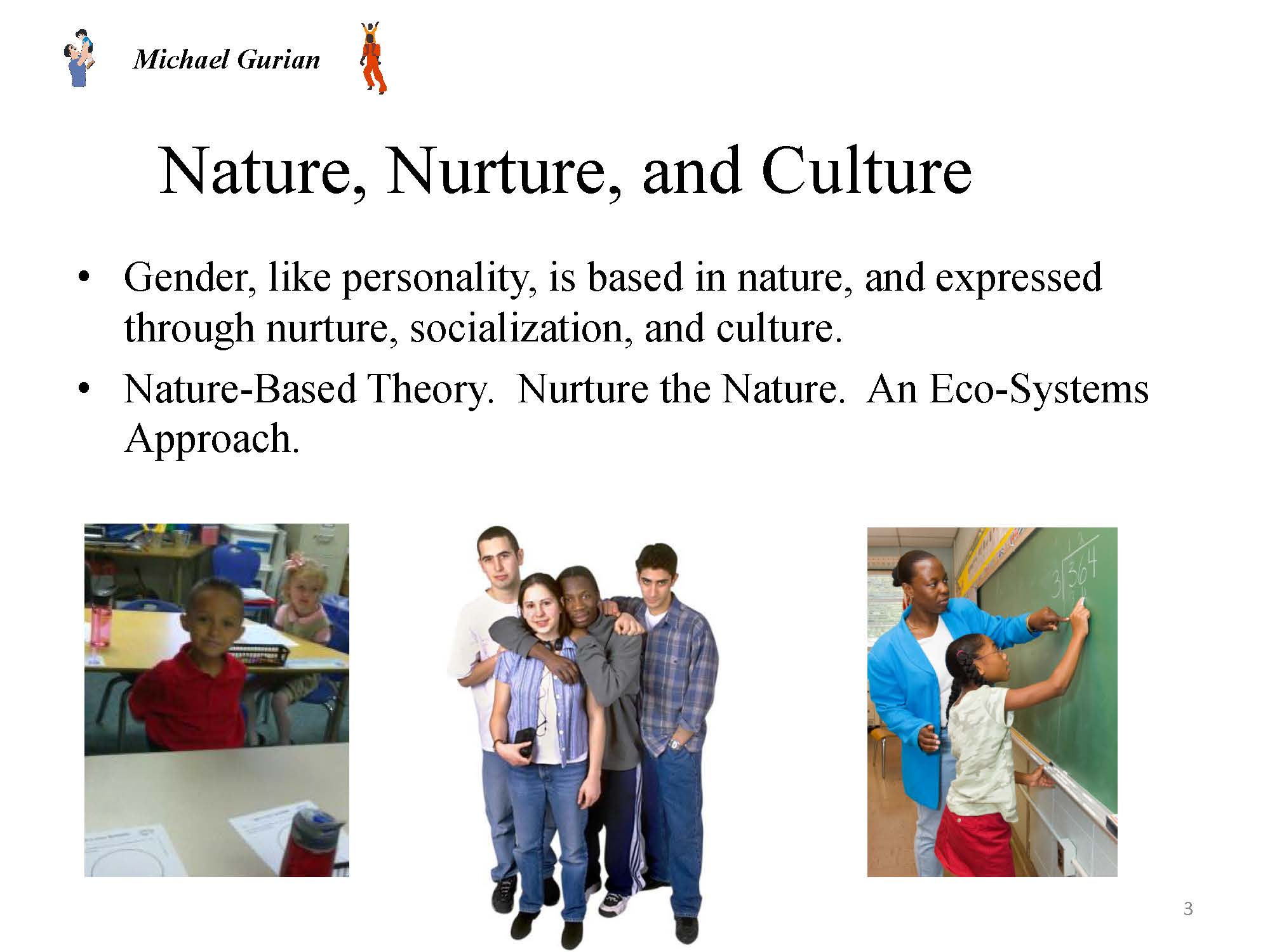This video course is divided into modules.
Module 1: How Boys and Girls Learn Differently
This one hour module takes the student into the male and female brains over the lifespan and focusing on early childhood and elementary age. You will delve into learning and play pattern differences between girls and boys by looking at PET, MRI, and SPECT scans that show how differently the male and female brains work. This information is crucial for people working with young children who have noticed, intuitively, certain male/female differences in their students and even in themselves but were unable to fully activate systemic adjustments in their childcare environments. As Michael Gurian shows brain scan results even from fetal brains (showing how male/female brain difference happen in utero), the three aspects of child development—nature, nurture, and culture—are revealed as operative on young children with nature finally understood much better. Now, issues with girls or boys in ECE environments make sense and strategies for handling those issues emerge.
Module 2: Behavior and Classroom Management Through a Gender Lens
Combining nature, nurture, and culture in their developmental arc, boys and girls develop social emotional learning differently, including bonding and behaving via somewhat different “norms.” Early childhood classrooms and environments lose approximately 4 boys for every 1 girl to suspension or expulsion. This one hour and forty minute module focuses on why that might be, looking carefully at male/female difference from the behavioral and classroom management lens. You will learn about play, bonding, and developmental patterns that impact daily interactions, and discover ways to turnaround boys’ higher failure rates in ECE. For example, male physicality is re-framed in this module to be understood, managed, and utilized in positive ways.
Module 3: Strategies for Teaching Our Youngest Boys and Girls
This one hour and forty minute module goes even more deeply into practical strategies and environmental tactics that teachers, coaches, case workers, parents, and others can employ to best help girls in STEM and boys in behavioral areas; girls in areas of “drama” and “in-out groups” and boys in literacy and word learning; girls in their learning challenges and boys in theirs. The strategies will be practical for all children and for the whole child but because they are presented through the sex and gender lens, they will also be acutely practical for working with boys and girls in their environments.
Some subtopics in these three modules include:
What Is Happening in the Brains of Boys and Girls?
Citizen Science as an Early Childhood Tool
Brain Scans of Gender Differences in the Developing Brain
Trauma and the Young Child’s Brain
Spatial and Movement-Based Teaching Strategies for Boys
Graphic and Visual Teaching Strategies for Boys
Male and Female Memory and Rumination
White Matter and Gray Matter Activity
Spatial Intelligence and Competitive Motivation
Aggression Nurturance and Empathy Nurturance
Boys, Self-Regulation, and Impulse-Control
Brains in the Rest State
Bi-Strategic Approaches, Risk, and Competition
Screen Time and the Prefrontal Cortex
Brain Breaks and Neurotoxins
Strategies that Use Movement
Bridge Brains, Trans brains, Gender Dysphoria, and LGBTQ from a Brain-Based Perspective
Movement and Mentoring
How Preschool Can Impact Girls and Women in STEM Fields
Math Strategies for Girls and Boys
Relational Aggression – Boundaries and Resilience
School Issues That Boys Especially Face
Helping Shy and Introverted Kids
Gross Boy Play
Tantrums and Anger
ADD/ADHD
Rumination Loops in Girls
How Women and Men Parent Differently
Strategies for Emotional Problem-Solving
Intervention and Non-Intervention
Teasing vs. Bullying
Strategies for Digital Health
Working with Sensitive Boys and Sensitive Girls
Perfectionism in Girls
Undermotivation in Boys
And Much More…
Module 4: Post-Test. We suggest you use this list of topics and/or the post-test as discussion points in your group.
Because this course comprises 6 hours of Professional Development, including discussion and post-test, it is perfect for PD days and/or weekly PD and Professional Learning Community meetings. If you would like to use the course this way, please email gail@gurianinstitute.com to let us know the number of students. You will be given a discount based on that number, then you will get access to all the files you need to run the PD.
Whether taken by an individual or by a group, funding for this course may come from any PD source, including school, local, state, or Title and other federal funds.
This Online Course and its Video and Written Content are Copyright © and Trademark® Protected, All Rights Reserved, Michael Gurian 2022, thus can only be used by the purchaser(s) of the course.








